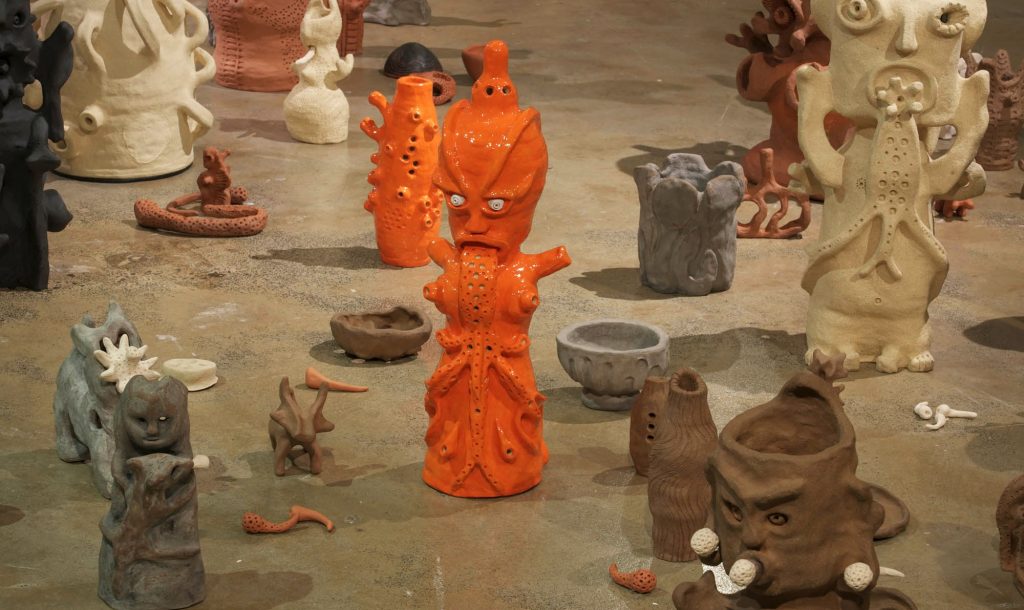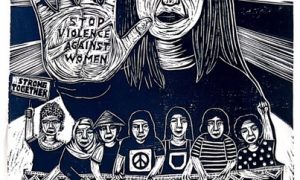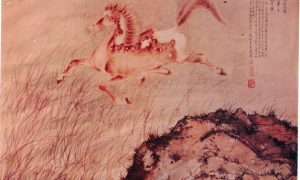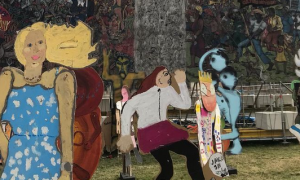Artist Mai Nguyen-Long has a conflicted relationship with her Vietnamese heritage, which she has been engaging with through her creative practice since the mid-1990s. At that time she spent a year in Vietnam where she studied Vietnamese language at Vietnam National University and the Art History of Vietnam and Life Drawing at the esteemed Vietnam University of Fine Arts. Born in Australia, her peripatetic childhood was spent in Papua New Guinea and the Philippines, before completing her BA and Masters in Australia, and more recently her undertaking a PhD in Creative Arts at the University of Wollongong.
New Mandala caught up with Mai while her latest body of work Vomit Girl (Berlin Cluster)—drawn from her doctoral practice-based research Vomit Girl Beyond Diasporic Trauma: Interconnecting Contemporary Art and Folkloric Practices in Vietnam—was on display at the 12th Berlin Biennale for Contemporary Art. A further iteration of Vomit Girl will be on display in Sydney for the first time alongside works by the esteemed photographer (and Mai’s mentor) William Yang, at Art Atrium in October, in an exhibition with the umbrella title Diasporic Dialogues.
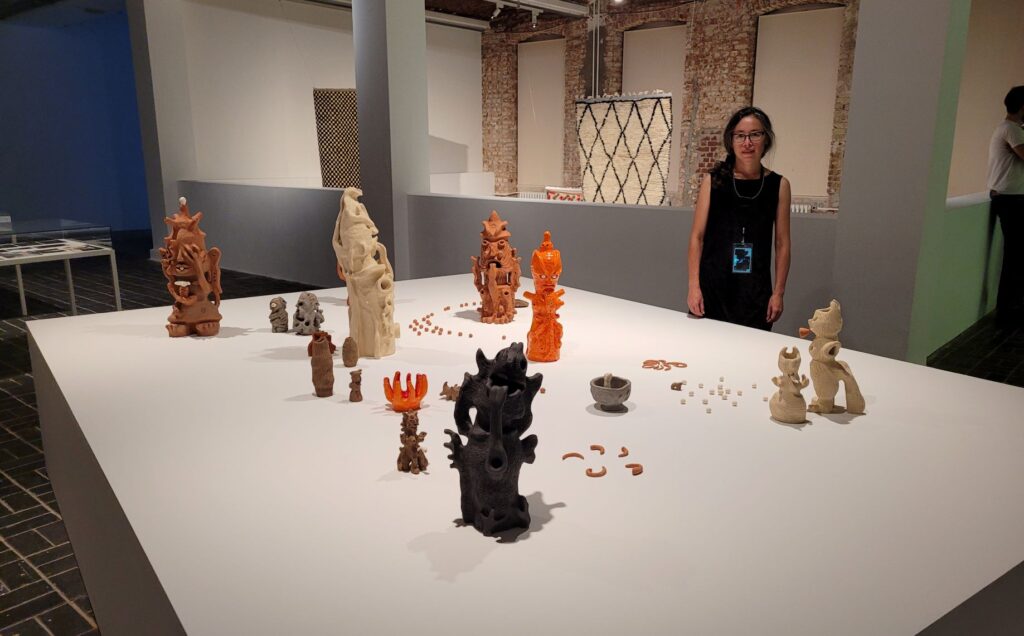
The artist with Vomit girl at the Berlin Biennale in 2022. Photo by Stuart Horstman, courtesy the artist.
Your previous works, especially Pho Dog (2006), Aqua Mutt: an installation with Dag Girl (2007), and The Burning of Godog (2009)—your mongrel dog series—have dealt with contested fields of political legitimacy in the Vietnamese diaspora in Australia, often with traumatic consequences for you. While these earlier works used papier mache, Vomit Girl sees you working with clay and drawing on Vietnamese đình wood carvings. What prompted the change in material and medium?
After my 2014 “Beyogmos” solo exhibition at Wollongong Art Gallery (WAG) I recognised that my entire artistic practice stemmed from this uncertain relationship with Vietnam. In particular I sensed an absence. Part of the process involved reformulating two of those papier-mâché sculptural precursors: 2006 Phở Dog Cordero—a mongrel censored in 2008’s Phở Dog Blackout —and a 2014 Vessel from “Beyogmos”.
Vessel is the splayed vivisected mongrel dog that set the visual language for exploring irreconcilable tensions across layered and fractured realities; it is also a metaphor for going beneath the skin. I constructed Vessel with used clothes gifted by my aunties in Vietnam, ripped maps, and broken mirrors for the histories embedded within these objects. Similarly, choosing materials for the biographies they already hold, Vomit Girl utilises clay’s embodiment of past and hidden stories carried by the weight of human histories, as a way of moving beyond “gated” narratives.
Staying in Bát Tràng ceramics village in 2015 exposed me Vietnam’s diverse ceramic histories. In particular, Nguyễn Đình Chiến drew my attention to the clay ritual vessels made in Thổ Hà with rich local iron oxide. This clay’s utilitarian history is interwoven with its ritual spiritual functions, such as containing disease to protect life. In the contemporary art context, ceramic’s reputation as a lowly material strengthened my resolve to use clay to draw out unofficial stories and histories, and relinking with narratives of the đình.
I first encountered đình woodcarvings nearly 30 years ago in the Red River Delta of northern Vietnam. In 1994 I studied and wrote about them in the Vietnamese language I had just acquired as part of a self-imposed language learning regime – as I was never taught Vietnamese at home. The đình woodcarvings that most resonate with me emerged during the Mạc Dynasty 1527-1592. When I saw them for the first time, as untreated woods, they were weather worn and war neglected. But the spaces that housed them felt dense with spirits and close to nature. The woodcarvings were a revelation, allowing me to imagine my Vietnamese heritage beyond the war images I had been saturated with.
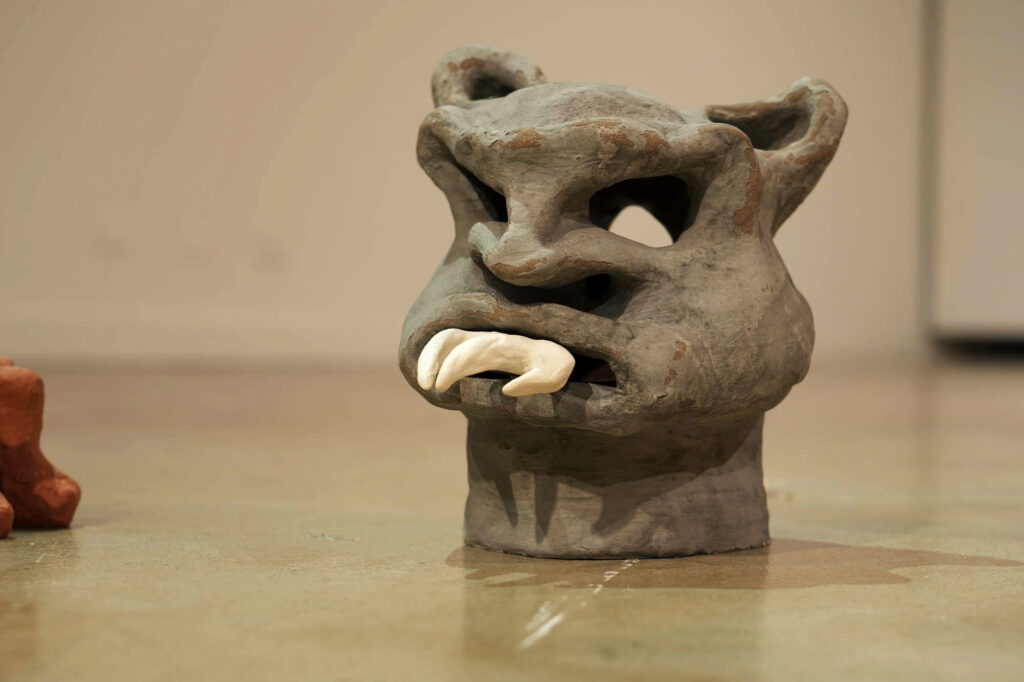
Photo by Martin Fox, courtesy the artist.
The playfulness of đình woodcarving informed my clay building method. Clay and its firing embody extensive histories too, processes of transformation, and older mythologies connecting humans to earth. This, and clay’s dual strength and vulnerability, furthered its suitability as my decolonising medium to explore possibilities for non-exclusive traumas.
The hopeful relationship that I developed with Vietnam in 1994 was challenged when I returned to Australia unwittingly speaking Vietnamese with a northern “communist” accent. I responded extremely by “deleting” my experiences in Vietnam. This vitriolic encounter triggered earlier experiences of rejection I had experienced in Australia. I believed that in Hanoi I had forfeited my right to be Asian Australian. I never spoke Vietnamese in Australia again.
In the đình woodcarvings I found playful irreverence and unorthodox expressions of Buddhism that formed strategies to mock and critique authority. In the 16th century, they were not made by specialist artisans, so the lively expression is comparatively raw. After being scapegoated as communist, I forfeited them from my imagination, as something too shameful to be associated with.
Following my “Beyogmos” exhibition, I became determined to return annually to Vietnam, and when I was offered a ceramics residency I grabbed it, even though it was a medium I was not particularly interested in and had never worked with before.
Making these clay Vomit Girl sculptures 23 years later helped me understand I had to reconnect with my đình encounters to help as a gesture of grounding. The different clays I experimented with and the forms that emerged instructed me to investigate the complexities of the significance of mộc mạc.
I first encountered the term mộc mạc in a 1975 Vietnamese language Hanoi publication featuring black and white photographs of 16th to 18th century đình woodcarvings. This was at a time when I could find no art books on Vietnam in Australia.
Mộc mạc is generally taken to mean rustic, rough, uncouth, or natural, simple. I think of it as earthy: an aesthetic guided by practical principles of survival, providing a primordial link to Vietnam’s indigenous nature spirit consciousness. I associated Nguyễn Phan Chánh’s 1931 silking painting Lên Đồng with the of mộc mạc aesthetic; depicting a Mother Goddess mediumship ritual, the painting’s subdued earthy palette was popular during the 1930s debates on aesthetics in Vietnam. I later learned the 1930s was also a time when the struggles for independence from France saw a rise in popular religion throughout Vietnam, thus further linking mộc mạc and Vomit Girl to resistance.
Considering also the possibility that đình expressive forms are linked to the pre-Chinese domination Đông Sơn culture, mộc mạc as resistance to suppressive aspects of Confucian governance increased my fascination with it. At the same time, exploring mộc mạc through clay invokes its ties with diverse experiences of suppression and domination, tempering notions of privileging đình cultural history.
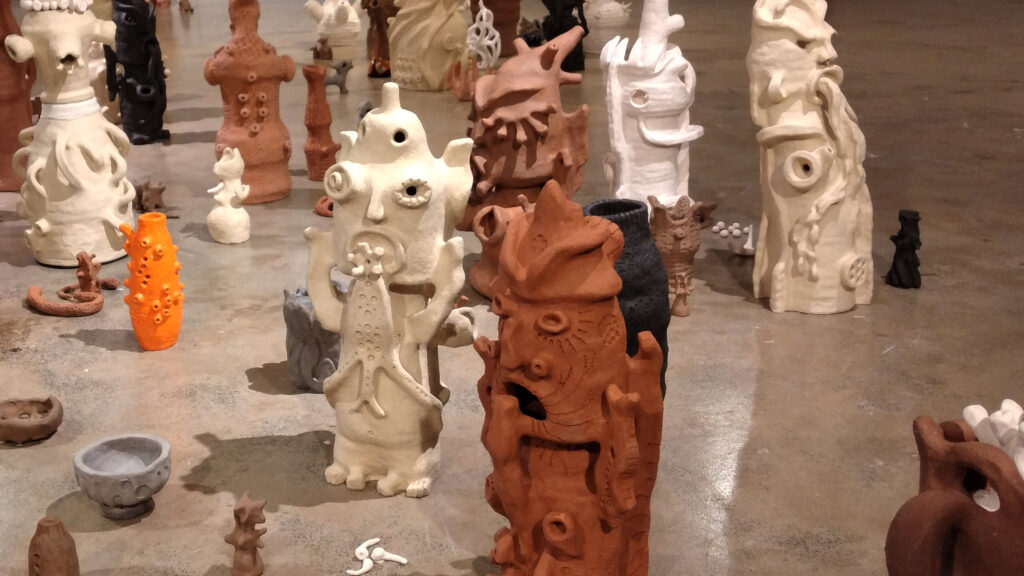
Photo by Elly Kent, Courtesy the artist.
Privileging the term mộc mạc in my research gestured to spiritual functionality rather than European art historical perspectives of beauty, which decolonial theorists Walter Mignolo and Rolando Vazquez explain is inseparable from the colonial matrix of power. Furthermore, referencing mộc mạc through the “lowly” medium of naked clay subverts debilitating shame by celebrating marginality.
Finally, transposing the mộc mạc of northern Vietnamese đình woodcarvings into clay disguises the source of my inspiration, challenging the notion that đình woodcarvings are “communist” by virtue of their geographic location. I understood aspects of mộc mạc as resistance to dominance of aesthetic and colonising forms of power—an aversion to superficial “perfection”. These were the reasons why I wanted to embrace mộc mạc not just as an adjective but as a complex, historically situated, yet marginal cultural concept.
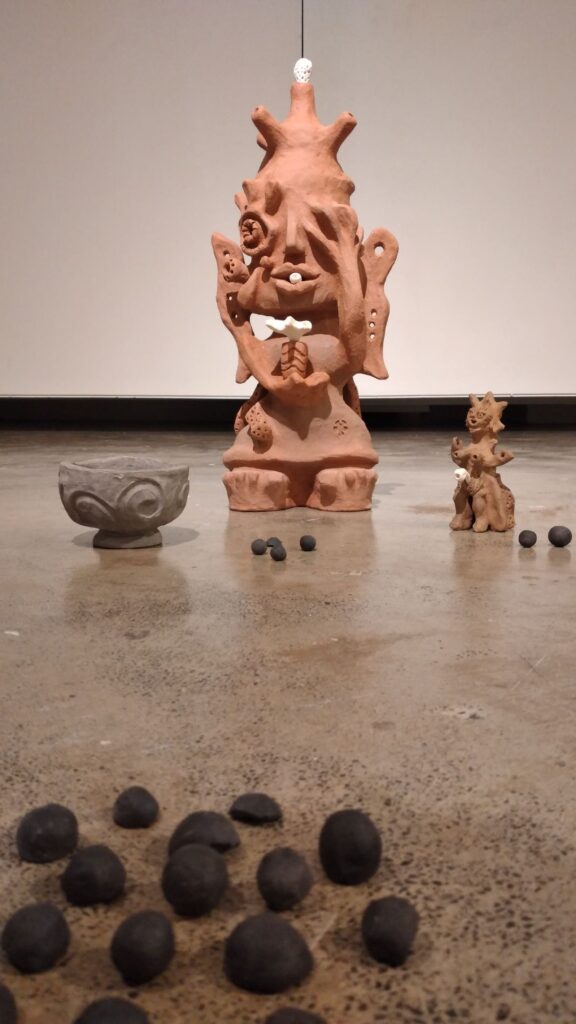
Photo by Elly Kent, courtesy the artist.
Through my Vomit Girl forms I took on mộc mạc on as my own device of spiritual resistance, but also sought to somehow deconstruct it. My desire to build objects to replace erased memories, generate new stories, transform destructive energies, and provide talismanic protection could never be ephemeral. Through my clay forms I pondered the dance between the aniconic and entrapment within the iconic.
My unglazed forms don’t replicate đình woodcarvings and they are sometimes completely abstracted, other times figurative. They cross between human/animal and although “girl” by name they are not gendered. They are the messy edges of memory and history.
The title Vomit Girl is provocative, and hints at a visceral connection between you and the works. Alongside the bright orange glaze and multitudinous, sometimes contorted figures, the body and it’s suffering seems a strong theme. Explain how you connect your physical self with metaphysical realisations through the work?
My choice to use orange glaze was informed multiple personal associations, including the Agent Orange affected foetuses I saw in the war museum in 1978, and by wider observations in the southern province of Sóc Trăng, where many of my extended family live. Bright colours can be observed in numerous Khmer pagodas and the garish colours of casual street wear. Buddhist monks there wear saffron robes. I also associate it with the destructive properties of Agent Orange, and a secondary colour formed by mixing the colours of the flags of a divided Vietnam (red and yellow). After several months of testing glazed clear colours, matt, shiny, on light and dark surfaces, mixing glazes, and layering colours I remained dissatisfied, torn between the “no colours” of mộc mạc, and the ‘kaleidoscopic colours’ of Sóc Trăng and my Phở Dog sculptures.
On one hand, mộc mạc aesthetics affirm my đình encounters, the naked clay speaking directly to the expansive histories and narratives suppressed by trauma in the Australian context. On the other hand, brightly coloured glazes subvert the shame of my “kitsch” Sóc Trăng heritage. Ultimately, I included the glazed objects in Vomit Girl to honour my Sóc Trăng lineage and the tensions between theory and practice in my work.
My awareness of my own trauma as an outsider, and consequent discombobulation, grew when I encountered Bracha Ettinger’s method of “artworking.” Ettinger explores how art generates ideas and the innate qualities that materials bring to a practice. I was drawn to artworking’s deconstruction of binary concepts, which was relevant to my exploration of stories beyond fixed narratives. Through this process Vomit Girl’s vomit becomes an ambiguous and tongue-like form. She takes on multiple names, the dominant being Vigit, my name for Vomit Girl: Goddess of Infected Tongues for all those who have lost their mother tongue.
Vomit Girl was first named after an impulsive pen drawing I made following an intense but undiagnosed physical illness in 2014. As she came to dominate my drawings, I had to ask uncomfortable questions and excavate the course of events leading to what I now perceived as psychic rupture. I realised the source of my physical throwing up was spiritual illness, related to rejecting my Vietnamese heritage in a context of rigid communist-anti-communist narratives, which limits space for more complex stories of “Vietnamese” identity.
Orange was the colour I chose for my first clay Vomit Girl iteration – from the saffron robes of Buddhist monks in my father’s hometown, a will to overcome divisiveness triggered by red and yellow boundary-marking motifs, and the ongoing destructiveness of Agent Orange.
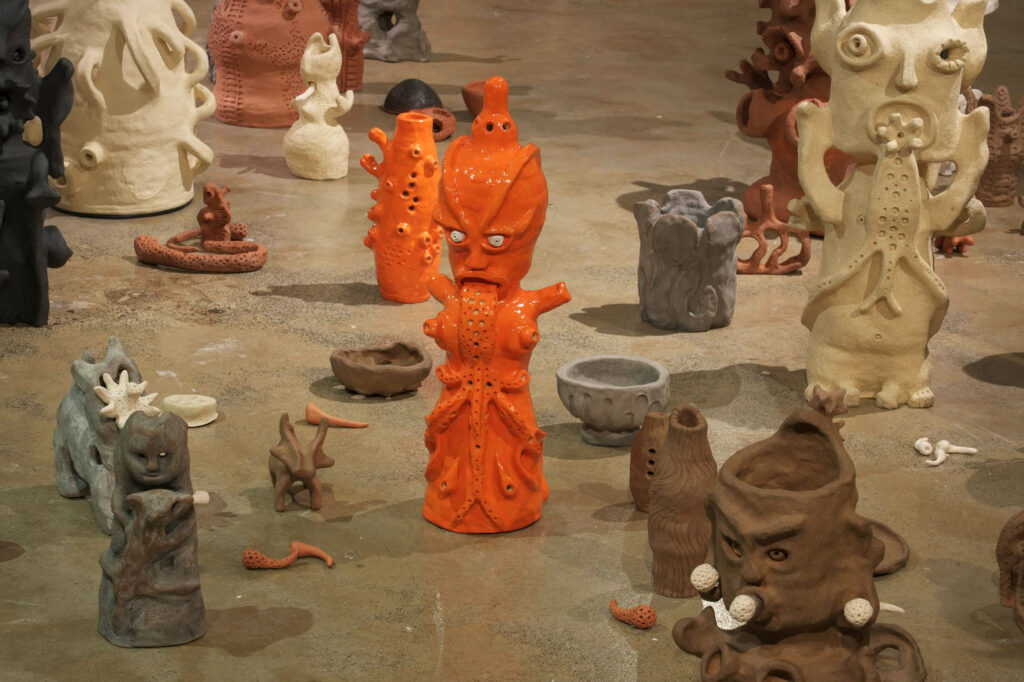
Photo by Martin Fox, courtesy the artist.
Girl references matriarchal systems said to be dominant in Vietnam prior to the introduction of male-centric Confucianism. In Mother Goddess (Đạo Mẫu) ritual practices, female mediums can be possessed by male spirits and male mediums possessed by female spirits, like my unfixed mental spaces when working with clay.
Thien Do (Đỗ Mỹ Thiện) draws parallels between the otherness explored in the ritualised dances of the Liễu Hạnh Mother Goddess worshipers with the fluidity of water. The snake accompanying Liễu Hạnh in northern Vietnam mirrors this fluidity. The role of mediumship attracts marginalised and oppressed groups such as women, homosexuals, and non-binary gender identities. The ritual is bodily, rather than intellectual or textual.
These folkloric practices present a way for communities and individuals to create their own histories, and in my work I mirror the decentralised nature of Mother Goddess expressions and their adaptive creative engagements with multiple histories and identities. Vomit Girl resists monolithic narratives, her forms swinging in and out of certainty. But central to her form is a will to build – to be a visible cultural artefact to replace my perception of what has been lost. An artefact as a gesture of hope, the hope to usher in different stories.
As well as the animal and human(girl)-like figures, you’ve also built a variety of bell-shaped objects that appear alongside them. What do these represent?
I call this cylindrical form Doba or my đình-bombshell-bell-axis; it is the structural basis for all of my Vomit Girl iterations in clay.
In 1994 I encountered a large rusty bombshell in a village in the Red River Delta. It had been repurposed as a đình courtyard bell. Surprised to again encounter such a bombshell bell in 2015, I adopted the symbol as a referential for Vomit Girl’s three-dimensional form; it is also a conceptual pivot to unlock Vomit Girl’s evolution as a dis/connect with the đình. I wanted to acknowledge the bombshell without amplifying its power through replication. Translating the metal form into clay defused its horror. It became an axis where I could imagine diverse and layered traumas converging, competing to cancel each other out. The markings I later developed from broken chopsticks, extracted human teeth, and endangered porcupine quill signified scars of interconnected traumas.
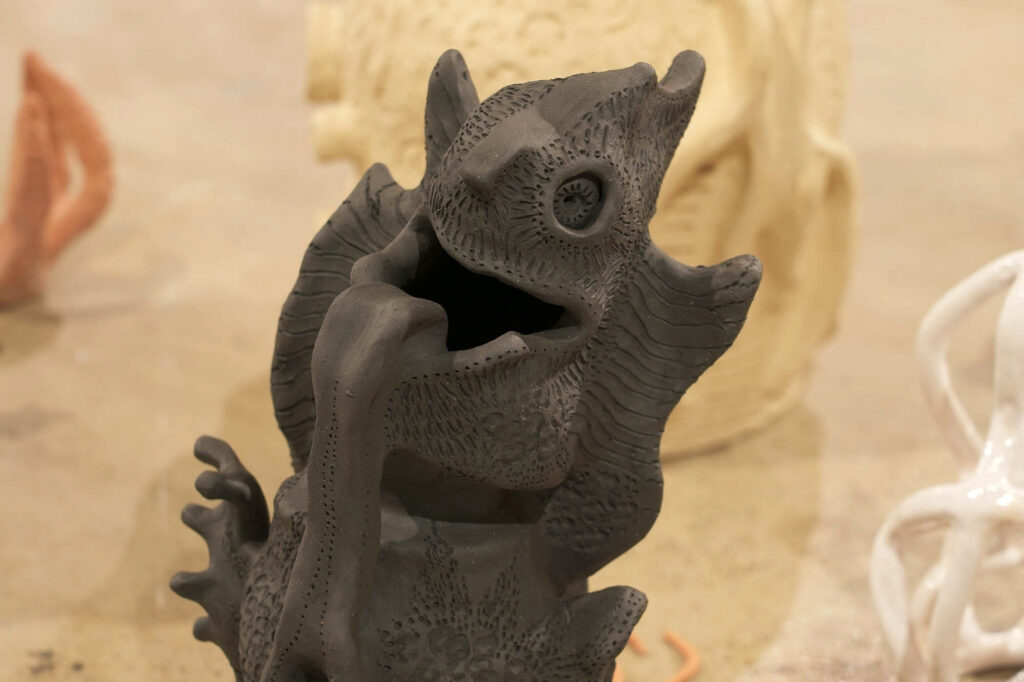
Photo by Martin Fox, courtesy the artist.
During my time in Vietnam, I interviewed contemporary artists, and was drawn to Đặng Thị Khuê, Phi Phi Oanh, Nguyễn Khắc Quân, and Nguyễn Bảo Toàn’s material and folkloric investigations. Đặng Thị Khuê shared with me a fascination with how different representations of dragons reflected divergent attitudes to power and control across changing dynasties. I came to relate the coil building method to the worm like dragons of the Lý Dynasty (1009-2225), a time where the flourishing of Buddhism and tolerance for diverse indigenous cults stimulated the arts. Đặng Thị Khuê described it as “not frightening or bullying like a Chinese dragon,” sharply highlighting thousands of years of aesthetics and identity defined by historical tensions.
Your work in Vomit Girl brings together folklore, heritage “crafts” and intergenerational trauma in a process that paradoxically resists and embraces the past and your own identity/identities. Do these objects have a function in the way that we understand art objects to have in “traditional” societies or spiritual practices? Are they cathartic?
Beyond cathartic, I would say they carry with them creative strategies for transformation and continuous reassessment of established knowledge systems. I am coming at this not as a complete insider nor a complete outsider. I’ve had to constantly question my own legitimacy in the process. These practices can offer alternative imaginings, particularly in a context where they have been discredited or replaced by other systems of “repair”.
However, like any system if it controls you and there is no stepping back to gain a critical perception, then it could equally be a blinding mechanism…it all depends on context and nuance. In the context of intergenerational trauma, craft offers me an alternative to hegemonic Art Historical narratives generated by power structures supported by fear, divisiveness, violence, and erasure. I don’t propose an exchange of one system for another, but a complex co-existence with contradiction and hypocrisy.
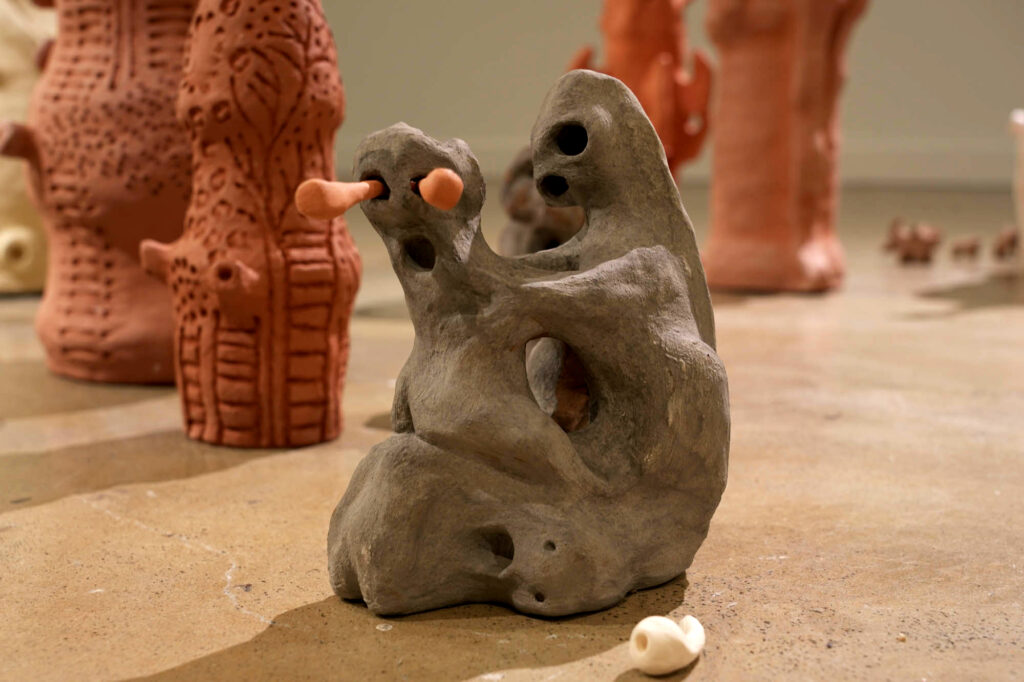
Photo by Martin Fox, courtesy the artist.
I am now more mindful about respecting my past and the encounters that have come to define me, no matter if they are meaningless or worthless to someone else.
Heritage is what one perceives it to be, if internalised racism is so powerful as to enact decades of systematic self-erasure, then it is no wonder spiritual illness and confusion results. Sometimes these empty spaces are filled with simplistic binary narratives because there simply are no systemic structures to support complexity.
By studying folkloric practices, my understanding of the convergence of infinite complexities was further opened. My appreciation for creative strategies of hiding and transformation as means of spiritual survival was enhanced. It has helped me contextualise the diversity of lineages within my own extended family, but also to begin to respect my own story of being Vietnamese or/and Australian, not as wrong but something both interconnected and autonomous at the same time.
Creative strategies embedded in heritage—in this case folkloric practices in Vietnam—offered me different ways of thinking, feeling and imagining beyond binary narratives. My doctoral research emerged from an urgent need to explore multiple interconnected traumas. Loss is an opportunity to re/create. This is the space where Vomit Girl has emerged, beyond diasporic trauma, interconnecting contemporary art and folkloric practice in Vietnam.
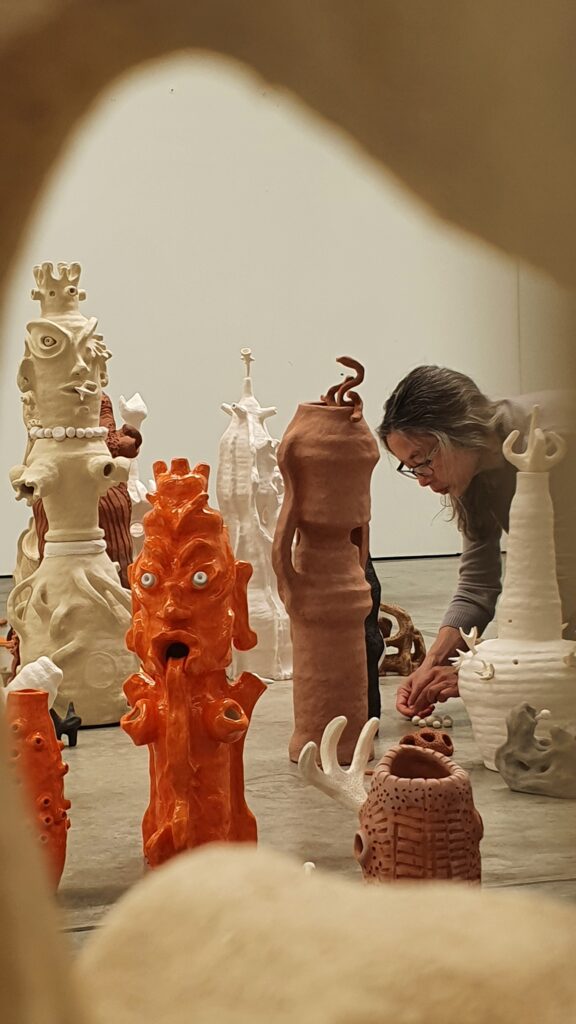
The artist installing her work at Art Atrium in 2022. Photo by Stuart Horstman, courtesy the artist.
Works from Mai Nguyen-Long’s Vomit Girl series can be seen at Art Atrium in Sydney from 8-22 October and in the Woollhara Small Sculpture Prize from 13 October to 20 November.
 Facebook
Facebook  Twitter
Twitter  Soundcloud
Soundcloud  Youtube
Youtube  Rss
Rss 